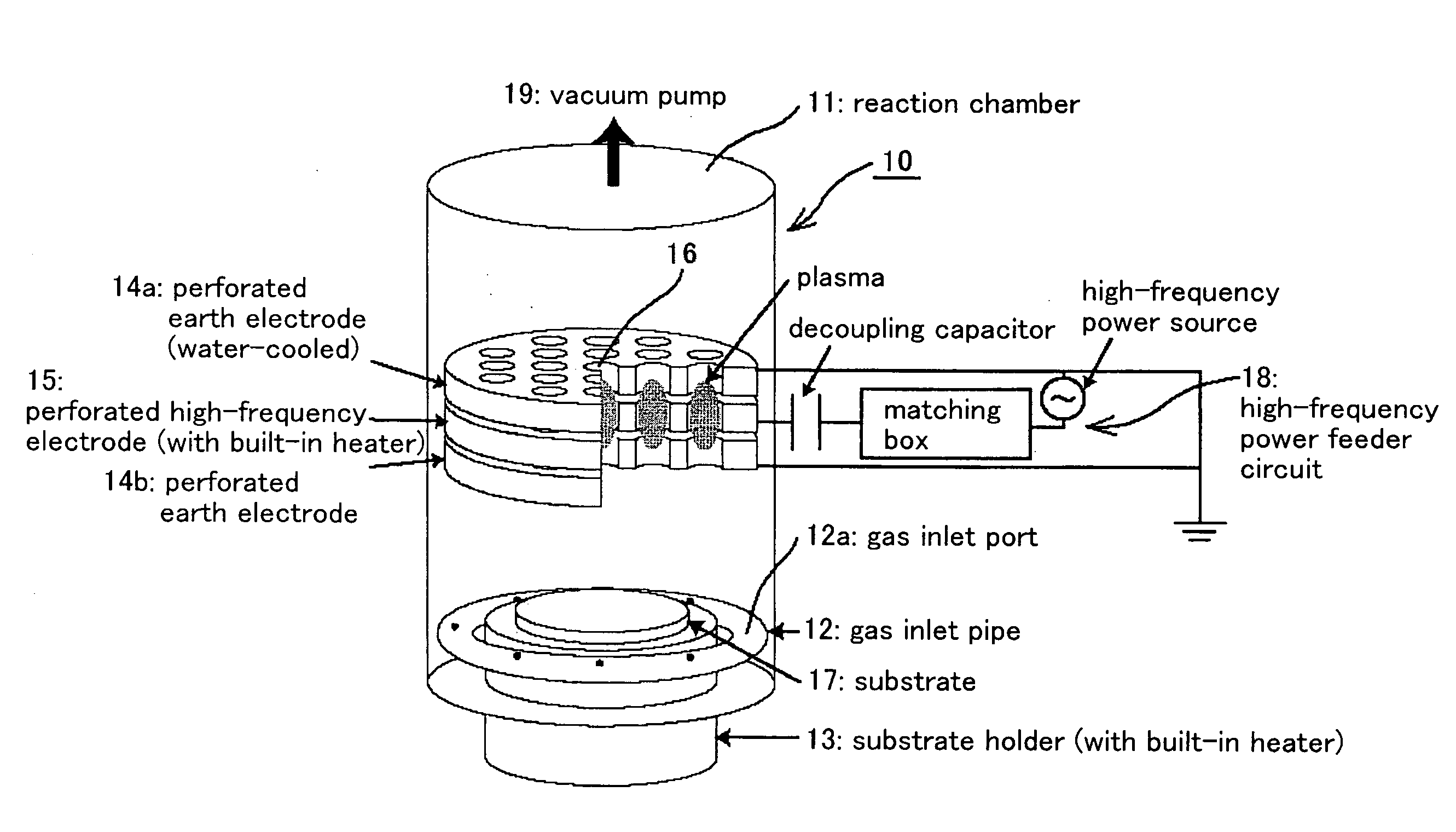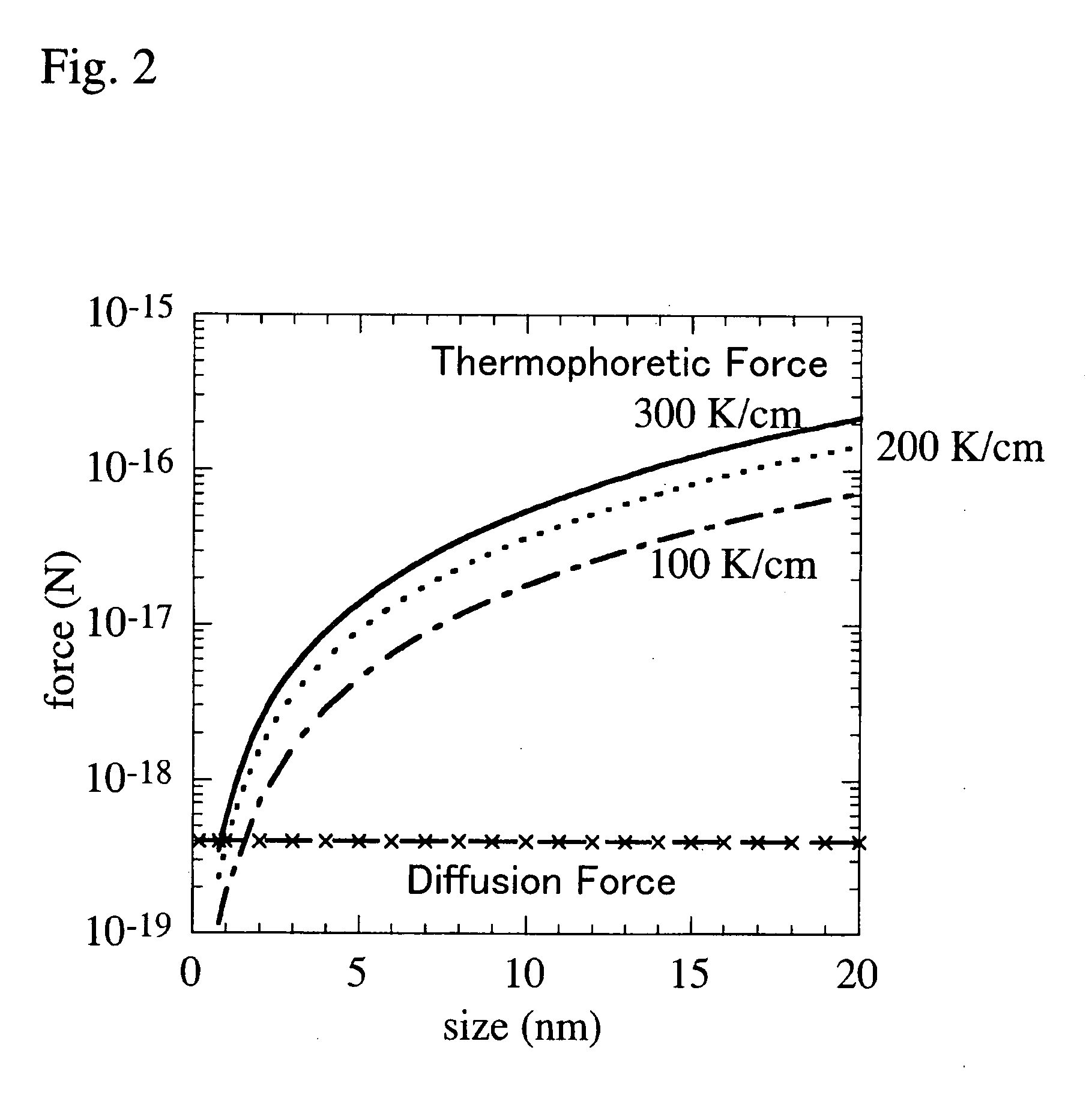Cluster-Free Amorphous Silicon Film, and Method and Apparatus for Producing the Same
a technology of amorphous silicon and amorphous silicon, which is applied in the direction of silicon compounds, sustainable manufacturing/processing, and final product manufacturing, etc., can solve the problem of light-induced degradation in a-si:h thin film deposited at a high rate, which is a long-standing major problem to be solved, and achieve the effect of lowering the film-deposition ra
- Summary
- Abstract
- Description
- Claims
- Application Information
AI Technical Summary
Benefits of technology
Problems solved by technology
Method used
Image
Examples
first embodiment
[0021] In a first embodiment of the present invention, a technique of increasing a gas flow rate in a plasma region, generating a thermophoretic force which acts on large clusters in gaseous phase, and capturing large clusters by an inner wall of a hole to remove the large clusters is used for preventing the incorporation of large clusters in an a-Si:H film to be deposited. FIG. 1 shows an amorphous silicon thin film deposition apparatus 10 (hereinafter referred to simply as apparatus 10″) using the above technique. As shown in FIG. 1, the apparatus 10 comprises a cylindrical-shaped reaction chamber (vacuum chamber) 11, a substrate holder 13 attached to a bottom of the reaction chamber 11 and provided with a gas inlet pipe 12, and a vacuum pump 19 connected to a top of the reaction chamber 11. A pair of perforated earth electrodes 14a, 14b and a perforated high-frequency electrode 15 are disposed parallel to each other within the reaction chamber 11, and a gas is directed to flow in...
second embodiment
[0030] In a second embodiment of the present invention, a cluster removal filter is used as one of large-cluster removal means. FIG. 7 shows an amorphous silicon thin film deposition apparatus 20 (hereinafter referred to simply as “apparatus 20”) using a cluster removal filter 21 as one of the large-cluster removal means. In this apparatus 20, a mesh-shaped high-frequency electrode 22, a mesh-shaped earth electrode 23 and a substrate 24 are disposed in a face-to-face arrangement within a reaction chamber (vacuum chamber) 25, and the cluster removal filter 21 is arranged immediately below the earth electrode 23. The mesh-shaped high-frequency electrode 22 and the mesh-shaped earth electrode 23 are disposed parallel to each other, and gas is directed to flow in a direction perpendicular to each surface of the electrodes. The substrate 24 may be made of Si, glass, stainless steel or polymer.
[0031] As shown in FIG. 7, the cluster removal filter 21 is arranged in a space through which a...
third embodiment
[0035] In a third embodiment of the present invention, a gas curtain (high-speed silane gas flow) is used as one of the large-cluster removal means, and employed in an amorphous silicon thin film deposition apparatus 30 (hereinafter referred to simply as “apparatus 30”) illustrated in FIG. 9 to produce a cluster-free a-Si:H film of the present invention. The apparatus 30 illustrated in FIG. 9 comprises a reaction chamber (vacuum chamber) 31 which houses a high-frequency electrode 32, an earth electrode 33 provided with a built-in heater and disposed in vertically opposed relation to the high-frequency electrode 32, and a substrate 34 adapted to allow an a-Si:H thin film to be deposited thereon and placed on the earth electrode 33. The apparatus 30 is designed to feed a high-frequency power generated by a high-frequency power feeder circuit (not shown) to the high-frequency electrode 32 to create a plasma in a silane gas introduced between the high-frequency electrode 32 and the eart...
PUM
| Property | Measurement | Unit |
|---|---|---|
| volume fraction | aaaaa | aaaaa |
| size | aaaaa | aaaaa |
| size | aaaaa | aaaaa |
Abstract
Description
Claims
Application Information
 Login to View More
Login to View More - R&D
- Intellectual Property
- Life Sciences
- Materials
- Tech Scout
- Unparalleled Data Quality
- Higher Quality Content
- 60% Fewer Hallucinations
Browse by: Latest US Patents, China's latest patents, Technical Efficacy Thesaurus, Application Domain, Technology Topic, Popular Technical Reports.
© 2025 PatSnap. All rights reserved.Legal|Privacy policy|Modern Slavery Act Transparency Statement|Sitemap|About US| Contact US: help@patsnap.com



